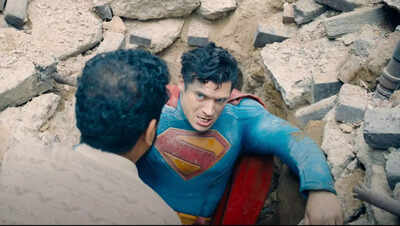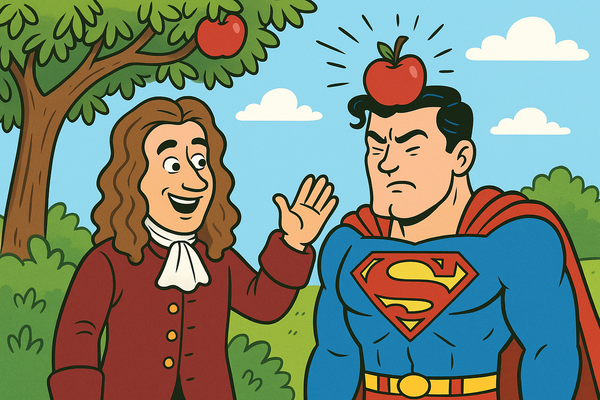
James Gunn’s Superman trailer just dropped, and on the surface, it looks like everything a long-suffering DC fan could hope for: a fresh-faced David Corenswet in a crimson cape, Rachel Brosnahan giving Lois Lane the journalistic fire she was denied for a decade, and a script that doesn’t feel like it was ghostwritten by Ayn Rand’s angsty clone. Superman, it appears, has taken it upon himself to unilaterally stop a war — no presidential authorisation, no international coalition, not even a WhatsApp group.“My actions? I stopped a war,” he tells Lois, clearly shocked that anyone might have a problem with unsolicited world peace. Noble. Heroic. Technically illegal. But while the internet debates whether this makes him a celestial saviour or a superpowered war criminal, it’s time we asked a far more urgent question:Why does Superman still kill the very people he’s trying to save?
Newton vs. Nostalgia: The First Law of Fatal Romance

Let’s assume you’re Lois Lane, tumbling from a skyscraper because, as always, Metropolis building codes are written by toddlers. You're accelerating at 9.8 m/s², picking up speed fast. Within seconds, you're falling at over 100 km/h. Enter Superman — faster than a speeding bullet, yes, but also apparently slower than a physics textbook.He swoops in and — BAM! — catches you two feet above the pavement.Except he doesn’t save you. He turns you into a smoothie with eyes.Even Sheldon Cooper explained this in The Big Bang Theory: “Lois Lane is falling, accelerating at an initial rate of 32 feet per second per second. Superman swoops down to save her by reaching out two arms of steel. Miss Lane, who is now travelling at approximately 120 miles per hour, hits them, and is immediately sliced into three equal pieces.”
The Big Bang theory - Sheldon's superman theory
If he really loved her, Sheldon concludes, he’d let her hit the pavement. At least it would be quick.
Not a Rescue — A Car Crash with Cape
This isn’t just snark — it’s science. When you're falling, everything inside you — bones, blood, lungs, leftover biryani — is hurtling toward Earth at terrifying speed. If Superman suddenly stops just your skin and bones, the rest of you keeps going. That’s inertia, Newton’s First Law. It’s why airbags exist. It’s why you wear seatbelts. It’s why you don’t stop a falling bowling ball with your chin. What comic books call a heroic rescue, physics calls blunt force trauma. In cinematic terms, it’s like trying to stop a train with a marble statue. Sure, it looks noble. But you still end up with a lot of broken pieces.Even Sheldon Cooper explained this in The Big Bang Theory: “Lois Lane is falling, accelerating at an initial rate of 32 feet per second per second. Superman swoops down to save her by reaching out two arms of steel. Miss Lane, who is now travelling at approximately 120 miles per hour, hits them, and is immediately sliced into three equal pieces.”If he really loved her, Sheldon concludes, he’d let her hit the pavement. At least it would be quic
The Real Physics of a Super-Save
Let’s pretend for a moment that Superman took a physics elective at Smallville High. To save someone properly, he’d need to:Match the person’s falling speed exactly to avoid that instant, fatal stopDistribute the stopping force evenly — think cuddly marshmallow, not vibrating granite slabDecelerate over a long distance, much like a fighter jet catching a tailhook on an aircraft carrierHe has to be an airbag with abs. A sentient parachute with perfect emotional control.But that’s not how it works in the movies. What we get instead is mid-air chest bumps and last-second dives that would, in the real world, result in death certificates stamped rescued to death.
Nice Guy. Still a Lethal Projectile.
The new trailer shows Superman in full battlefield mode — explosions, tanks, civilians running, Superman flying through it all like a heat-seeking missile of justice. And yes, we see him saving civilians in the middle of the chaos. But unless Gunn’s Superman also got a PhD in biomechanics and kinetic energy dispersal, every single one of those civilians is internal organ soup.Intentions don't override physics. Not even if you wear your underwear over your pants.Superman 2.0: Bold, Brooding, and Biologically RiskyTo be fair, this version of Superman is clearly different. He questions his role. He’s not a Snyderverse grimdark god, nor a silver-age cornball in spandex. Gunn’s Superman looks like someone who actually cares. But unfortunately, no amount of compassion can cancel out the square of velocity.That’s the thing with pop culture — it loves to romanticise these death-defying moments while neatly ignoring the literal defiance of death. Which is why, scientifically speaking:Falling from a height: DangerousSuperman catching you instantly: FatalSuperman obeying physics: UnlikelyBest-case scenario: Land on a trampoline. Or Aquaman.
The Cape Is Cool, But Gravity Still Wins
Superman | Official Trailer | DC
So yes, James Gunn’s Superman might just be the reboot DC desperately needed. Corenswet has the sincerity. Brosnahan has the grit. Luthor looks deliciously sociopathic. And the story? Actually coherent.But the physics? Still deadly.Until proven otherwise, Superman’s greatest power isn’t flight, strength, or heat vision — it’s plot armour that lets him defy Newton without consequences.If you ever find yourself plummeting from a skyscraper, don’t pray for Superman. Pray for a physicist. Or at least a really big pillow.Because in the real world, the cape doesn’t save you. The maths does.

 1 month ago
141
1 month ago
141




























 English (US)
English (US)